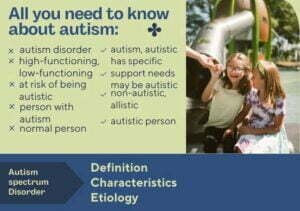
Definition of Autism Spectrum Disorder (ASD): Autism spectrum disorder is a condition related to brain development that impacts how a person perceives and socializes with others, causing problems in social interaction and communication. The disorder also includes limited and repetitive patterns of behavior.
Autism Language Impaired (ALI) is a condition in which abnormalities in the structure and function of the left hemisphere of the brain are linked to language form impairment (De Fosse et al., 2004).
Definition of Autism Spectrum Disorder (ASD)
The developmental disease known as autism spectrum disorder (ASD) has an impact on behavior and communication. While a diagnosis of autism can be made at any age, the condition is referred to as a “developmental disorder” since its symptoms typically manifest in the first two years of life.Autism Spectrum Disorder (ASD), often referred to simply as autism, is a complex and multifaceted neurodevelopmental condition that affects individuals in a wide range of ways. It’s important to delve into the intricacies of this disorder to truly comprehend its meaning and significance in the lives of those it touches. In this article, we will define Autism Spectrum Disorder, explore its various characteristics, and emphasize the importance of understanding and supporting individuals with ASD.
DSM – V define Autism Spectrum Disorder
People with ASD share the following characteristics, per the Diagnostic and Statistical Manual of Mental Disorders (DSM-5), an American Psychiatric Association diagnostic manual:
- Having trouble interacting and communicating with others
- Restricted interests and repetitive behaviors
- Symptoms that hurt the person’s ability to function properly in school, work, and other areas of life
Autism is referred to be a “spectrum” disorder due to the wide range of symptom severity and kind that individuals may encounter.Despite the possibility that ASD is a lifelong condition, there are programs and therapies that can help with symptoms and functional abilities. It is advised by the American Academy of Pediatrics that all kids get tested for autism. ASD screening and evaluation should be discussed by all caregivers with their clinician.
Autism Definition
Autism is a neurodevelopmental disorder that impacts an individual’s social interactions, communication skills, and behavior. It is referred to as a “spectrum” because it encompasses a wide range of symptoms, skills, and levels of impairment.
Prevalence of Autism Spectrum Disorders (ASD)
According to estimates made by Baio et al. (2018), the prevalence of ASD in 8-year-old children was 16.8 per 1,000, or 1 in 39. 1 in 40 (2.5%) children aged 3 to 17 years old were considered to have an ASD by their parents, according to the 2016 National Survey of Children’s Health (NSCH) (Kogan et al., 2018). According to Baio et al. (2018), variations in policy and area regarding children’s access to diagnostic and evaluation services may account for a portion of the variance observed in prevalence estimate systems.
A Study done on Indian children published on National Institute of Health (NIH) titled as “Prevalence of Autism Spectrum Disorder among Rural, Urban, and Tribal Children” found 43 children, aged 1 to 10 years, were identified as having ASD out of a total of 28,070 children in tribal, urban, and rural areas; this represents a 0.15% prevalence.
Characteristics of Autism Spectrum Disorder (ASD)
Autism Spectrum Disorder is characterized by a wide range of signs and symptoms that vary in severity and presentation.
Signs of Autism Spectrum Disorder (ASD)
Social challenges: Having trouble building relationships, maintaining eye contact, and communicating emotions with others. Conversational interaction and social cue interpretation can be challenging for those with ASD.
Communication Difficulties: ASD is characterized by delayed or impaired language development. While some people might not speak at all, others might use repetitive language or exhibit echolalia, which is the repeated use of words or phrases.
Repetitive Behaviors: Repeated and stereotyped activities, such as hand flapping, rocking, or arranging objects in a line, are referred to as repetitive behaviors. They could also have very particular hobbies.
Sensory Sensitivities: Increased or decreased sensitivity to light, sound, texture, or taste in the senses can result in sensory sensitivity.
Rigidity: The inability to adjust to changes in everyday activity and a preference for routines.
Symptoms of Autism Spectrum Disorder (ASD)
Impaired Social Interaction: Having trouble interpreting nonverbal signs such as body language and facial expressions can lead to impaired social interaction. minimal enthusiasm for discussing experiences with others.
Communication Challenges: Communication problems include gesturing or pointing excessively, speaking too little or not at all, and having trouble starting or maintaining conversations.
Repetitive Movements: Flapping hands, rocking back and forth, and other repetitive movements. insistence on customs or uniformity.
Sensory Differences: An excess or under sensitivity to stimuli that cause the body to react in certain ways, such as covering one’s ears in loud noises or losing awareness of pain or temperature changes.
Fixated Interests: Paying close attention to one particular interest or subject matter, frequently to the detriment of other pursuits.
Diagnosis of Autism Spectrum Disorders (ASD)
Diagnosing autism typically occurs in early childhood, with signs becoming apparent between the ages of 2 and 3. The diagnostic process involves assessing a child’s behavior, development, and communication skills.
Early intervention and support are essential for individuals with autism, often known as those with autism spectrum disorder (ASD). The symptoms of autism vary, as does how each person is affected. Early evaluation contributes to a better knowledge base and network of support for individuals with autism. Numerous evaluation instruments are employed, such as
- Diagnostic and Statistical Manual of Mental Disorders (DSM-5)
- Autism Diagnostic Observation Schedule (ADOS)
- Childhood Autism Rating Scale (CARS)
- Social Communication Questionnaire (SCQ)
- Autism Diagnosis Interview – Revised (ADI-R)
- Autism Diagnostic Observation Schedule – Generic (ADOS-G)
- Gilliam Autism Rating Scale – Second Edition (GARS-2)
- INDIAN SCALE FOR ASSESSMENT OF AUTISM (ISAA)
- Screening Tool for Autism in Toddlers and Young Children (STAT)
- Autism Detection in Early Childhood (ADEC)
- Autism Services, Education, Resources, and Training Collaborative (ASERT)
- Modified Checklist for Autism in Toddlers, Revised (M-CHAT-R)
These tools aid healthcare professionals in providing the best possible support and care for individuals on the Autism spectrum. Early assessment and ongoing evaluation are essential for a lifelong condition like Autism.
Autism Spectrum Disorder Meaning: Support and Acceptance
Understanding ASD is crucial for several reasons. First and foremost, it helps us appreciate the diversity of human experiences. Recognizing that individuals with autism have unique perspectives and abilities fosters inclusion and acceptance in our communities. Additionally, understanding ASD allows us to provide the necessary support and resources to help individuals with autism thrive in various aspects of life, including education, employment, and daily living.
Support and early intervention are key in enhancing the quality of life for individuals with ASD. This often includes speech and occupational therapy, behavioral interventions, and individualized educational programs. Families, educators, and healthcare professionals play pivotal roles in providing the needed support to those with ASD.
Conclusion
Autism Spectrum Disorder is a complex and multifaceted condition that affects individuals in a wide range of ways. Its definition extends beyond a mere diagnosis, emphasizing the need for understanding, acceptance, and support. By recognizing the unique strengths and challenges of individuals with ASD, we can work towards a more inclusive and compassionate society that empowers every individual, regardless of their neurodiversity.
Frequently Asked Question related to Autism Spectrum Disorder (ASD)
What is Autism Spectrum Disorder (ASD)?
Autism Spectrum Disorder, commonly referred to as ASD, is a neurodevelopmental condition that affects an individual’s ability to interact and communicate with others, as well as their behavior and interests. ASD is characterized by a wide range of symptoms and severity, forming a spectrum of challenges and abilities unique to each person with the condition.
What is the meaning of Autism Spectrum Disorder?
The meaning of Autism Spectrum Disorder lies in its complexity. It encompasses a diverse set of traits and behaviors that can affect individuals in various ways, making it essential to understand and accommodate this diversity. ASD signifies a lifelong condition characterized by differences in social interaction, communication, and sensory experiences.
How do you define Autism Spectrum Disorder?
Autism Spectrum Disorder is defined as a neurodevelopmental disorder that encompasses a range of challenges, including difficulties in social communication, atypical behaviors, and individualized sensory sensitivities. It is often diagnosed in early childhood, and the term “spectrum” reflects the variability in how ASD manifests in different individuals, from mild to severe.
What does ASD mean?
ASD is an abbreviation for Autism Spectrum Disorder, a term used to describe a group of neurodevelopmental conditions. The abbreviation helps facilitate discussions and research about this complex condition.
Can you provide a concise autism definition?
Autism is a neurodevelopmental condition characterized by challenges in social communication, repetitive behaviors, and sensory sensitivities. It is a spectrum disorder, meaning it varies in severity and symptoms from one individual to another. Understanding and accommodating these differences is crucial for supporting individuals with autism.
References:
- Language Disorders from Infancy to Adolescence 4th Edition – Rhea Paul (Book)
- Assessment in Speech Language Pathology A Resource Manual 5th Edition, Kenneth G. Shipley, Julie G. McAfee (Book)
You are reading about:
Definition of Autism Spectrum Disorder (ASD)







0 Comments